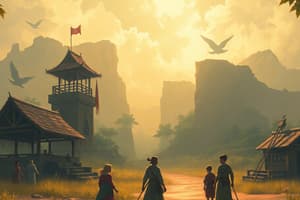Podcast
Questions and Answers
Define Culture.
Define Culture.
Symbols of expression that individuals, groups, and societies use to make sense of daily life and to articulate their values.
Define Mass Communication.
Define Mass Communication.
The process of designing cultural messages and stories and delivering them to large and diverse audiences through media channels.
Define Mass Media.
Define Mass Media.
The cultural industries that produce and distribute cultural products to large numbers of people.
What are the key technological breakthroughs that accompanied the transition to the print and electronic eras? Why were these changes significant?
What are the key technological breakthroughs that accompanied the transition to the print and electronic eras? Why were these changes significant?
Explain the key features of the digital era and the concept of media convergence.
Explain the key features of the digital era and the concept of media convergence.
Explain the linear model of mass communication and its limitations.
Explain the linear model of mass communication and its limitations.
In looking at the history of popular culture, explain why newer and emerging forms of media seem to threaten status quo values.
In looking at the history of popular culture, explain why newer and emerging forms of media seem to threaten status quo values.
Describe the skyscraper model of culture. What are its strengths and limitations?
Describe the skyscraper model of culture. What are its strengths and limitations?
Describe the map model of culture. What are its strengths and limitations?
Describe the map model of culture. What are its strengths and limitations?
What are the chief differences between modern and postmodern values?
What are the chief differences between modern and postmodern values?
What are the five steps in the critical process? Which of these is the most difficult and why?
What are the five steps in the critical process? Which of these is the most difficult and why?
What is the difference between cynicism and criticism?
What is the difference between cynicism and criticism?
Why is the critical process important?
Why is the critical process important?
Flashcards are hidden until you start studying
Study Notes
Culture
- Culture encompasses symbols and expressions that individuals and groups use to interpret daily life and articulate values.
Mass Communication
- Defined as designing and delivering cultural messages and stories to a large, diverse audience through various media channels, ranging from traditional print to modern Internet platforms.
Mass Media
- Refers to the cultural industries that produce and distribute various forms of entertainment and information, including songs, TV shows, newspapers, and video games to large audiences.
Transition to Print and Electronic Eras
- Key technological developments included the emergence of film in the early 20th century and radio in the 1920s, culminating in the influential rise of television during the 1950s and 1960s, marking the start of a new visual and electronic era.
Digital Era and Media Convergence
- In the digital era, different formats of media (images, texts, sounds) are converted into electronic signals and reproduced across multiple platforms, such as cable TV and social media.
- Media convergence describes the merging of content across media channels, highlighting changes in media companies and content delivery.
Linear Model of Mass Communication
- The linear model represents mass communication as a system with senders, messages, and receivers. However, it oversimplifies the complexity of communication, which often does not follow a straightforward path from sender to receiver.
Impact of Mass Media on Culture
- Mass media influences individual awareness, cultural attitudes, and public policy, often altering the status quo and challenging traditional values.
Skyscraper Model of Culture
- High culture (ballet, classical literature) occupies the top floors, while popular or low culture (soap operas, video games) is found at the bottom. Strengths include categorization of culture; limitations arise from the oversimplification of cultural value.
Map Model of Culture
- Represents culture as complex and multifaceted, acknowledging various directions and forms. It captures the duality of familiar and innovative cultural narratives, providing both stability and challenge.
Modern vs. Postmodern Values
- Modern values emerged with the Industrial Revolution, focusing on individualism, rationality, and efficiency while rejecting tradition.
- Postmodern values (1950s-present) embrace diversity, challenge hierarchies, and question established reasoning, highlighting cultural recycling and paradox.
Five Steps in Critical Process
- Description: Observing and researching the subject.
- Analysis: Identifying significant patterns in data.
- Interpretation: Understanding the implications of findings.
- Evaluation: Making judgments based on critical over personal perspectives.
- Engagement: Acting as a citizen to influence media and culture.
- Most challenging step: Engagement, as it necessitates connecting personal insights with broader societal actions.
Cynicism vs. Criticism
- Cynicism denotes a distrustful attitude towards others' motives, while criticism involves the detailed examination and judgment of cultural and media content.
Importance of the Critical Process
- Cultivating a critical perspective fosters media literacy, allowing for informed participation in discussions about the role of media in democracy and consumer culture.
Studying That Suits You
Use AI to generate personalized quizzes and flashcards to suit your learning preferences.




